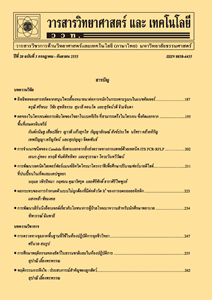ผลของสารควบคุมการเจริญเติบโตและชนิดของอาหารสูตร MS ต่อการเจริญเติบโตและการพัฒนาของต้นหนอนตายหยาก
Main Article Content
Abstract
บทคัดย่อ
การศึกษาอิทธิพลของสารควบคุมการเจริญเติบโตที่มีต่อการชักนำชิ้นส่วนของข้อจากต้นหนอนตายหยากที่เลี้ยงในสภาพปลอดเชื้อ เพื่อชักนำให้เกิดแคลลัส และการเกิดยอดจำนวนมาก เพาะเลี้ยงชิ้นส่วนของข้อโดยเปรียบเทียบระหว่างการเพาะเลี้ยงบนอาหารวุ้น Murashige and Shoog (MS) และในอาหารเหลว ½ MS ที่เติมฮอร์โมน 6- benzyl adenine (BA) ความเข้มข้น 0, 1, 3 และ 5 มก./ล. ร่วมกับฮอร์โมน 2,4-dicholophenoxy acetic acid (2,4-D) ความเข้มข้น 0, 0.1, 0.5 และ 1 มก./ล. เป็นระยะเวลา 4 สัปดาห์ พบว่าปริมาณฮอร์โมนที่ BA ความเข้มข้น 5 มก./ล. ร่วมกับฮอร์โมน 2,4-D ความเข้มข้น 0.1 มก./ล. มีความเหมาะสมในการชักนำให้เกิดแคลลัสทั้งในอาหารเหลว ½ MS และอาหารวุ้นสูตร MS คือ มีอัตราการเกิดแคลลัส 80 และ 60 เปอร์เซ็นต์ ตามลำดับ และการเกิดยอดจำนวนมากพบในอาหารเหลว ½ MS และอาหารวุ้นสูตร MS ที่เติมฮอร์โมน BA 5 มก./ล. โดยมีค่าเฉลี่ยของการเกิดยอดสูงสุด คือ 7.8 และ 6.0 ยอดต่อชิ้นส่วนเนื้อเยื่อ แสดงให้เห็นว่าผลของสารควบคุมการเจริญเติบโตในอาหารทั้งสองแบบมีความคล้ายคลึงกัน แต่การเพาะเลี้ยงในอาหารเหลว ½ MS สามารถชักนำการเกิดแคลลัส และยอดจำนวนมากของต้นหนอนตายหยากได้สูงกว่าเพาะเลี้ยงบนอาหารวุ้นสูตร MS เป็นผลมาจากมีพื้นที่ผิวสัมผัสกับอาหารในสภาพอาหารแข็งมีน้อยกว่า
คำสำคัญ : หนอนตายหยาก; สารควบคุมการเจริญเติบโต; แคลลัส
Abstract
Influence of plant growth regulators (PGR) on callus formation and shoot multiplication from node of Stemona collinsae was investigated using in vitro culture technique. Each node segment was cultured on solid Murashige and Shoog (MS) and liquid ½ MS medium supplemented with 0, 1, 3 and 5 mg/l of 6-benzyl adenine (BA) and combined with or without 0, 0.1, 0.5, and 1 mg/l of 2, 4-dicholophenoxy acetic acid (2,4-D). The growth of S. collinsae node in these different concentrations of PGR and two different states of culture medium was evaluated after a period of four weeks. The results showed that the at 5 mg/l BA with 0.1 mg/l 2,4-D promoted maximum percentage of callus formation in both liquid and solid medium about 80 and 60 percent, respectively. Moreover, highest number of shoot was found in solid MS and liquid ½ MS medium supplemented 5 mg/l BA having 7.8 and 6.0 shoots per plantlet respectively. The plant growth regulators had influence on callus production and shoot multiplication in both types of medium showing similar results. Therefore, liquid medium was more suitable for inducing shoot multiplication and callus formation than solid medium due to increased contact surface of plant samples to medium.
Keywords: ; Stemona collinsae; plant growth regulator; callus


